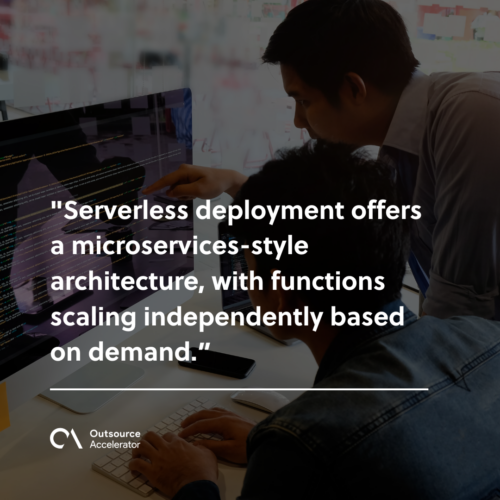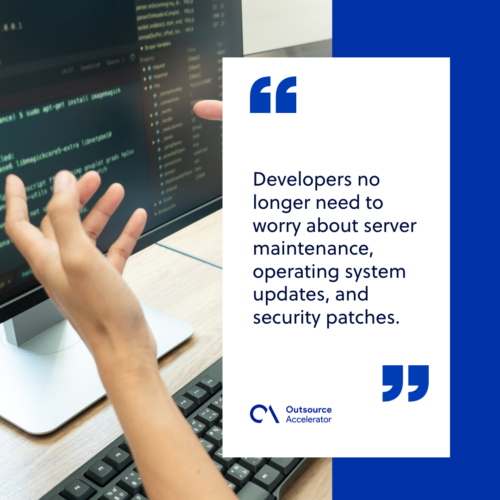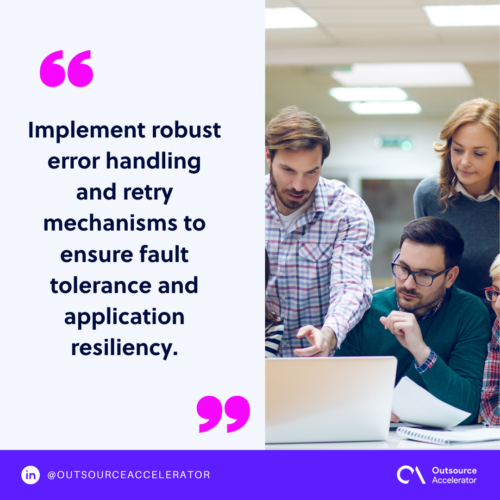Defining serverless deployment and how it works

Serverless deployment has become a transformative method in the world of application development.
This innovative approach eliminates the need for traditional infrastructure management, letting developers focus solely on writing code.
According to Datadog, function-as-a-service (FaaS) solutions are the primary driver of serverless popularity. It found that cloud providers use one or more serverless solutions.
Let’s further delve into the concept of serverless deployment. This article explores its benefits, challenges, best practices, and what lies ahead for this cutting-edge technology.
What is serverless deployment?
Despite the name, serverless deployment doesn’t mean no servers are involved. Instead, developers don’t need to manage the servers themselves.
When you deploy a serverless application, you’re essentially outsourcing server management to a cloud provider like AWS Lambda, Azure Functions, or Google Cloud Functions.
In serverless architecture, you break down your application into small, independent functions. Specific events or requests trigger each function and run in an isolated environment.
Serverless deployment offers a microservices-style architecture, with functions scaling independently based on demand.

Benefits of serverless deployment
Serverless deployment brings many benefits, making it a preferred choice for many organizations:
Low-cost
Serverless deployments offer a ‘pay-as-you-go’ pricing model. It reduces costs by eliminating the need for fixed infrastructure.
Using serverless technology, organizations are billed solely for the precise duration of function execution.
Scalability and flexibility
Serverless platforms automatically scale apps based on demand. It guarantees optimal performance even during peak loads.
This inherent scalability eliminates the need for manual infrastructure scaling. It also seamlessly accommodates sudden spikes in traffic.
Rapid development
Developers can focus solely on coding business logic without worrying about infrastructure management. Going serverless accelerates time to market, increases productivity, and reduces development cycles.
Reduced operational overhead
Serverless deployment reduces the operational burden by removing infrastructure management.
Developers no longer need to worry about server maintenance, operating system updates, and security patches.

Enhanced resource utilization
With serverless architectures, resources are allocated dynamically, ensuring efficient utilization and reduced waste.
Functions are only invoked when triggered, allowing for better resource and cost allocation.
Challenges of serverless deployment
Serverless deployment also presents unique challenges that developers and organizations need to address:
Vendor lock-in
Serverless platforms differ across cloud providers, creating a degree of vendor lock-in. Migrating from one provider to another may require significant code modifications.
This makes it crucial to consider the chosen platform’s long-term implications carefully.
Cold start delays
When functions are executed after idling for a certain period, they may experience a noticeable delay known as a “cold start.”
This delay can impact the responsiveness of applications, particularly those with real-time requirements. Proper architectural considerations and provisioned concurrency can mitigate this challenge.
Lack of control over infrastructure
While serverless deployment simplifies infrastructure management, it limits control over the underlying environment.
Companies may face restrictions on available software, configuration options, and network settings. Proper planning and understanding of platform limitations are vital to overcome these challenges.
Choosing a serverless deployment strategy
When selecting a serverless deployment strategy, evaluating your specific use case is essential. Take these factors into account when you plan your deployment process:
- Cloud provider. Choose a cloud provider that aligns with your business needs, as each has its own ecosystem and pricing structure.
- Service integrations. Assess the integration capabilities of the serverless platform with other cloud services.
- Performance requirements. Determine the expected load and performance needs of your applications.
- Cost considerations. Understand the pricing model of the serverless platform and ensure it fits your budget.
Choosing the right strategy based on specific application requirements is also crucial. Two common approaches include:
- Pure serverless. All application logic is implemented as functions triggered by events or HTTP requests.
- Hybrid serverless. Critical components with long execution times or specialized infrastructure needs can be implemented using traditional architectures.
Best practices for serverless deployment
To ensure successful serverless deployment, consider adopting the following best practices:
Design for event-driven architecture
Serverless is ideal for event-driven architectures. Design functions that respond to specific events or triggers. This results in efficient resource utilization and minimizes idle time.
Optimize function granularity
Fine-tune the granularity of functions to strike a balance between efficient resource use and minimizing cold start delays.
Smaller, more focused functions offer better performance and scalability.
Leverage managed services
Take advantage of managed services offered by serverless platforms. They could have databases, storage, and authentication functions.
These services remove operational overhead, providing scalability and security without burdening the development team.
Implement robust error handling
Since serverless is a distributed system, failures can occur. Implement robust error handling and retry mechanisms to ensure fault tolerance and application resiliency.

Future of serverless deployment
Serverless deployment is still a rapidly evolving technology with promising growth potential. Gartner predicts that by 2025, 50% of global enterprises will have adopted serverless computing.
More organizations will likely adopt this approach as the serverless ecosystem matures and cloud providers enhance their offerings.







 Independent
Independent




